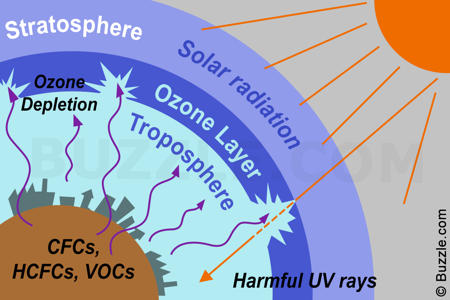Introduction
Genetic Engineering is the process involves the modification of genetic information, like our DNA, and through this, the final product will be able benefit the host. Genetic Engineering is widely used to increase crops output, benefit or improve the health of all living things and producing vaccines.
Firstly, the genes in plants can be modified to allow a better adaption in a harsher environment such as weather, or they can resist certain herbicides or any toxic materials. In addition, the modification of genes can benefit humans’ welfare through consumption. For example, the genetic-modified (GM) corns.
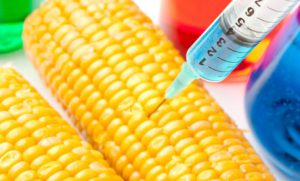
Figure 1: Genetically modified Corn
References: http://www.care2.com/greenliving/tumors-linked-to-genetically-modified-corn.html
The corns were modified so that they are resistance to this herbicide called glyphosate. It was introduced by a corporation, Monsanto, and the product was named, roundup ready corn in 1996. Corns are also modified which resulting them to express a certain protein from this bacteria, bacillus thuringiensis. This protein, Bt protein, acts as an insecticide and get rid of corn ear worms and root worms that destroy crops and affect the harvest. The proteins are expressed throughout the plant and affect the worms digestion system, leading to starvation.
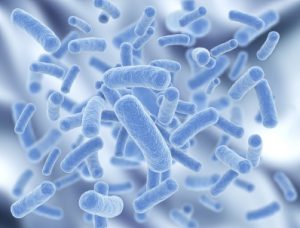
Figure 2: Bacillus thuringiensis
References: http://www.biosciencetechnology.com/article/2013/10/tiny-swimmers
Secondly, animals like cows can be genetically modified to bring benefits to the human health. About 20 percent of the daily cows are given growth hormones, allowing them to grow at a faster rate and increase the overall products. Cows produce milk and some of the growth hormones that are given to them are present in the milk. These growth hormones in the milk can enter into the human body through consumption and help people who are lacking in growth hormones.
Some animal also genetically modified to produce things they usually don’t, like “Freckles” female goats which have been modified to produce spider silk which can be used in many ways due to its toughness
Other animals especially mice also genetically altered to act as an animal model for human disease in some scientific research. These mice have been used in some study of diseases such as diabetes, arthritis, substance abuse, and Parkinson. Mice is chosen because their size and also because their genetic, biological and behaviour characteristic is similar to those of humans
Lastly, genetic engineering can contribute medicine. Insulin, a medicine used to maintain the sugar level in your body and prevent the sugar level from rising too high or dropping too low, It involves the replacement of nucleus in the cell and the cell will then perform the new function.
Genetic engineering can really bring many advantages in this world, but there is also a downside of something beneficial in our life. With the changes made in genes, the natural ecosystem will be affected, as well as the biodiversity.
Gmo corns:
Herbicide resistant maize
Corn which resistant to glyphosate herbicides was introduced with the name “roundup ready corn” in 1996 by Monsanto. Later “Liberty link corn” which is resistant to glufosinate and clearfield which is resistant to imidazoline was introduced. However, clearfield was bred using tissue culture selection which not governed by the regulatory framework governing the approval of transgenic crops ( I didn’t add this section, as it is not approved.
Insecticide producing corn
Bt corn is maize which can express protein from bacterium bacillus thuringiensis which is poisonous to certain insect and pest
Drought resistant
The first transgenic drought tolerance trait in a line of corn hybrids called DroughtGard by Monsanto in 2013
References
https://en.wikipedia.org/wiki/Genetically_modified_maizehttps://www.theguardian.com/science/2012/jan/14/synthetic-biology-spider-goat-geneticshttps://en.wikipedia.org/wiki/Genetically_modified_mouse
Chemical Concept
What are genes?
Genes are the basic physical and functional units of heredity, which are made up of DNA and act as instructions to make protein molecules for biological functions in living organisms.
What is DNA?
Deoxyribonucleic acid (DNA) is a molecule that carries the genetic code crucial to the growth, development, functioning and reproduction of all living organisms. The biological information in DNA is essential for all living organisms. DNA molecule exists as two twisted strands of polynucleotides. The simplest form of DNA is monomer called nucleotide. Each nucleotide consists of one of the four nitrogen-containing nucleobases—cytosine (C), guanine (G), adenine (A), or thymine (T)—and a sugar called deoxyribose and a phosphate group.
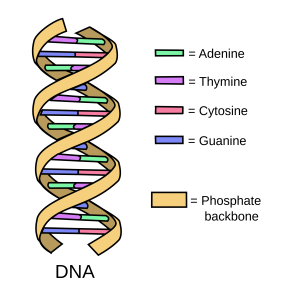
Figure 3: DNA structure
Process of genetic engineering
In genetic engineering, recombinant DNA is made artificially to modify some genes of organisms such as plants and crops in order to increase the yields. The recombinant DNA can be transformed into organisms in the form of plasmids or in the appropriate format, by utilizing a viral vector. For example, the soil bacterium Bacillus thuringiensis contains 150 insect toxins, some of which is commonly utilised in organic agriculture to kill insect pests. The tomato plant’s beetle resistance comes from a gene in the Bacillus thuringiensis which scientists inserted into the tomato plant’s genome. This gene called calledcry1Ac, encodes a protein that is toxic to certain types of insects, including the beetle. The genes coding for the toxic proteins have been isolated and transferred to crop plants such as maize, potato and cotton. If insects eat the leaves, they will be killed. The most widely advertised transgene is one which prevents the expression of a softening enzyme in tomatoes allowing them to be ripened on the plant whilst reaching the supermarket sufficiently firm for sale.
To illustrate the chemical concepts of genetic engineering, we are going to use the example of “Creation of an Insect Resistant Tomato Plant”.
Step 1: Find an organism that naturally contains the desired trait, in this case, a bacterium with insect resistance gene. The DNA is then extracted from the organism and cut out a small sequence of gene that control the traits of resistance of insects.
Step 2: Insert the gene into a vector with an antibiotic resistance gene. In genetic engineering, a vector is a DNA molecule used as a vehicle to artificially carry foreign genetic material into another cell, where it can be replicated expressed.
George Acquaah (16 August 2012). Principles of Plant Genetics and Breeding. John Wiley & Sons Inc. ISBN 9781118313695.
Step 3: Vectors are copied in the bacteria Bacillus thuringiensis.
Step 4: Coat tungsten or gold particles with DNA vectors
Step 5: Load vector-coated particles onto teflon bullet
Step 6: Load the bullet into a gene gun ( the “gene-gun” approach is one of several gene transfer methods).
Step 7: Shoot the gene gun to release the particles at high velocity penetrating the plant cells.
Step 8: The vectors go into the plant cells and the genes are incorporated into the plant genome. The foreign DNA is now transferred into host cells and combines with the host genome.
Step 9: The cells are placed on a selective antibiotic media. Only cells that have incorporated the vector will grow. These cells will be an important growing factor for tomato plants with new features.
Step 10: These cells are transferred to the media containing plant growth factor and culture the root tips to the plantlet stage. Finally, tomato plants with new trait of resisting insects are produced.
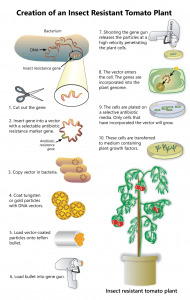
Figure 4: Step by step process of the genetic engineering of the tomato plant
References
https://ghr.nlm.nih.gov/primer/basics/gene
http://www.sciencegroup.org.uk/ifgene/heaf.htm
http://learn.genetics.utah.edu/content/science/gmfoods/ (GM tomato, benefits and risks of GM food)
http://futurehumanevolution.com/basic-concepts-in-genetic-engineering
Applications
Genetic Engineering: Application # 1. Application in Agriculture:
An important application of recombinant DNA technology is to alter the genotype of crop plants to make them more productive, nutritious, rich in proteins, disease resistant, and less fertilizer consuming. Recombinant DNA technology and tissue culture techniques can produce high yielding cereals, pulses and vegetable crops.
Some plants have been genetically programmed to yield high protein grains that could show resistance to heat, moisture and diseases.
Some plants may even develop their own fertilizers some have been genetically transformed to make their own insecticides. Through genetic engineering some varieties have been produced that could directly fix atmospheric nitrogen and thus there is no dependence on fertilizers.
Scientists have developed transgenic potato, tobacco, cotton, corn, strawberry, rape seeds that are resistant to insect pests and certain weedicides.
Bacterium, Bacillus thurenginesis produces a protein which is toxic to insects. Using the techniques of genetic engineering, the gene coding for this toxic protein called Bt gene has been isolated from bacterium and engineered into tomato and tobacco plants. Such transgenic plants showed nee to tobacco horn worms and tomato fruit worms. These genotypes are awaiting release in USA.
Efforts are being made to improve several agricultural crops using various techniques of genetic engineering which include:
(i) Transfer of nitrogen fixing genes (nif genes) from leguminous plants into cereals.
(ii) Transfer of resistance against pathogens and pests from wild plants to crop plants.
(iii) Improvement in quality and quantity of seed proteins.
(iv) Transfer of genes for animal proteins to crop plants.
(v) Development of cell lines which may produce nutritious food in bioreactors.
Genetic Engineering: Application # 2. Application to Medicine:
Genetic engineering has been gaining importance over the last few years and it will become more important in the current century as genetic diseases become more prevalent and agricultural area is reduced. Genetic engineering plays a significant role in the production of medicines.
Microorganisms and plant-based substances are now being manipulated to produce a large amount of useful drugs, vaccines, enzymes and hormones at low costs. Genetic engineering is concerned with the study (inheritance pattern of diseases in man and collection of human genes that could provide a complete map for an inheritance of healthy individuals.
Gene therapy by which healthy genes can be inserted directly into a person with malfunctioning genes is perhaps the most revolutionary and most promising aspect of genetic engineering. The use of gene therapy has been approved in more than 400 clinical trials for diseases such as cystic fibres emphysema, muscular dystrophy, adenosine deaminase deficiency.
Gene therapy may someday be exploited to cure hereditary human diseases like haemophilia and cystic fibrosis which are caused by missing or defective genes. In one type of gene therapy, new functional genes are inserted by genetically engineered viruses into the cells of people who are unable to produce certain hormones or proteins for normal body functions.
Vaccines:
Recombinant DNA Technology is also used in the production of vaccines against diseases. A vaccine contains a form of an infectious organism that does not cause severe disease but does cause immune system of the body to form protective antibodies against the infective organism. Vaccines are prepared by isolating antigen or protein present on the surface of viral particles.
When a person is vaccinated against a viral disease, antigens produce antibodies that act against the viral proteins and inactivate them. With recombinant DNA technology, scientists have been able to transfer the genes for some viral sheath proteins to vaccinia virus which was used against small pox.
Vaccines produced by gene cloning are contamination free and safe because they contain only coat proteins against which antibodies are made. A few vaccines are being produced by gene cloning, e.g., vaccines against viral hepatitis influenza, herpes simplex virus, virus-induced foot and mouth disease in animals.
Production of Blood clotting factors:
Normally heart attack is caused when coronary arteries are blocked by cholesterol or blood clot. plasminogen is a substance found in blood clots. Genetically engineered tissue plasminogen activator (tPA) enzyme dissolves blood clots in people who have suffered heart attacks. The plasminogen activator protein is produced by genetech company which is so potent and specific that it may even arrest a heart attack underway.
Cancer:
Cancer is a dreaded disease. Antibodies cloned from a single source and targetted for a specific antigen (monoclonal antibodies) have proved very useful in cancer treatment. Monoclonal antibodies have been targeted with radioactive elements or cytotoxins like Ricin from castor seed to make them more deadly. Such antibodies seek cancer cells and specifically kill them with their radioactivity or toxins.
Genetic Engineering: Application # 3. Energy Production:
Recombinant DNA technology has tremendous scope in energy production. Through this technology, it is now possible to bioengineer energy crops or biofuels that grow rapidly to yield huge biomass that used as fuel or can be processed into oils, alcohols, diesel, or other energy products.
The waste from these can be converted into methane. Genetic engineers are trying to transfer gene for cellulase to proper organisms which can be used to convert wastes like sawdust and cornstalks first to sugar and then to alcohol.


